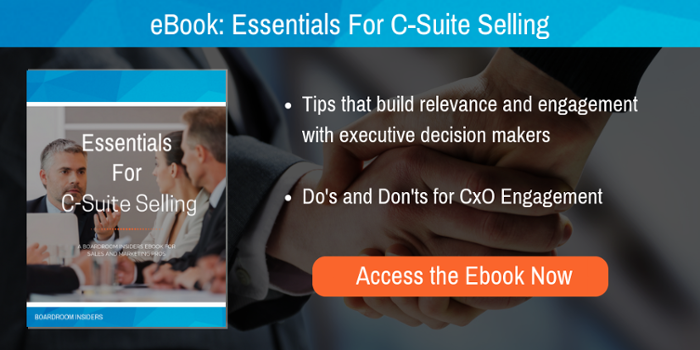.png?width=700&name=Business%20Conversation%20Nailing%20the%20First%205%20Minutes%20(1).png)
It's 2017 and IDC sees a future where C-Level executives are going to be more central than ever to critical technology buying decisions.
According to IDC FutureScape: Worldwide IT Industry 2017 Predictions:
Over the next three to four years, DX [digital transformation] efforts will no longer be "projects," "initiatives," or "special business units"…every (growing) enterprise — no matter its age or industry — will become a "digital native" in the way its executives and employees think and how they operate…Competing and thriving in the DX economy will demand improvements in performance in all aspects of the enterprise, including leadership, revenue growth, customer engagement, operational efficiency, and workforce agility.
IDC adds that as a result of this rapid and dramatic shift:
- 33% of CEOs will have technology leadership experience
- Enterprises with advanced DX maturity will execute 50% reductions in management layers
What does this mean for technology vendors targeting the enterprise?
1. They did their homework on him, his company and his business initiatives
2. They speak his language and have an idea that can support one of his business initiatives
3. They have monetized the value of what they are proposing
If the sales rep effectively communicates these three things in the first few minutes of the meeting, they've got his ear. If they don't, he said, the meeting gets cut short and you won't get a second chance. Time is the most valuable thing he has, he said, so he's not going to waste it with someone who doesn't "speak the same language."
The Winning Formula
What then, is the right formula for mapping out your 5-minute business conversation?
1. Start With Insight: Show you understand their business and the environment in which they are operating. For example, if their major pain point is that their business is becoming commoditized, call that out.
2. A Good Idea: Next, present an idea (which includes your offering) and how it could address the business challenge(s) you just described.
3. Defend or Reference The Idea: Prove you have done this before by citing other customers you have helped, or a specific case study that mirrors what you are proposing for them. Credibly demonstrate how the company would monetize the investment by either showing savings or revenue impact.
4. The Ask: Don't leave next steps to chance. Ask for their business and their ongoing personal sponsorship of your engagement. This is important because so many deals that get pushed down the chain of command die on the vine in absence of strong executive sponsorship.
Critical Success Factors
The challenge is, most sales organizations are not set up to support this approach.
"The way you question executives is dramatically different from what is taught in most sales trainings, " said Conrad Smith, Corporate Visions' VP of Consulting Services. This fact, he said, leaves reps feeling unprepared and even fearful to sell higher in the organization.
The key to success is feeling confident and well-prepared, which requires research and prep time.
Our COO said that a rep should spend four times as much time preparing for the meeting as the meeting actually takes. So for example, prepping for a 30-minute meeting should take at least two hours. His recommended process is as follows:
1. Research the company and the executive.
2. Outline the insight and the idea you plan to share, and how you are going to reference and defend it (see points 1-3 above). Don't forget the monetization piece.
3. Place calls to any contacts or champions you have lower in the company to verify and validate that you are on the right track with what you plan to present.
If you have covered all your bases, says the COO, your chances of getting more than 5 minutes--and the executive's commitment to some next steps--are good. "Speaking their language is what creates the hot start," he concluded.








Share Your Thoughts